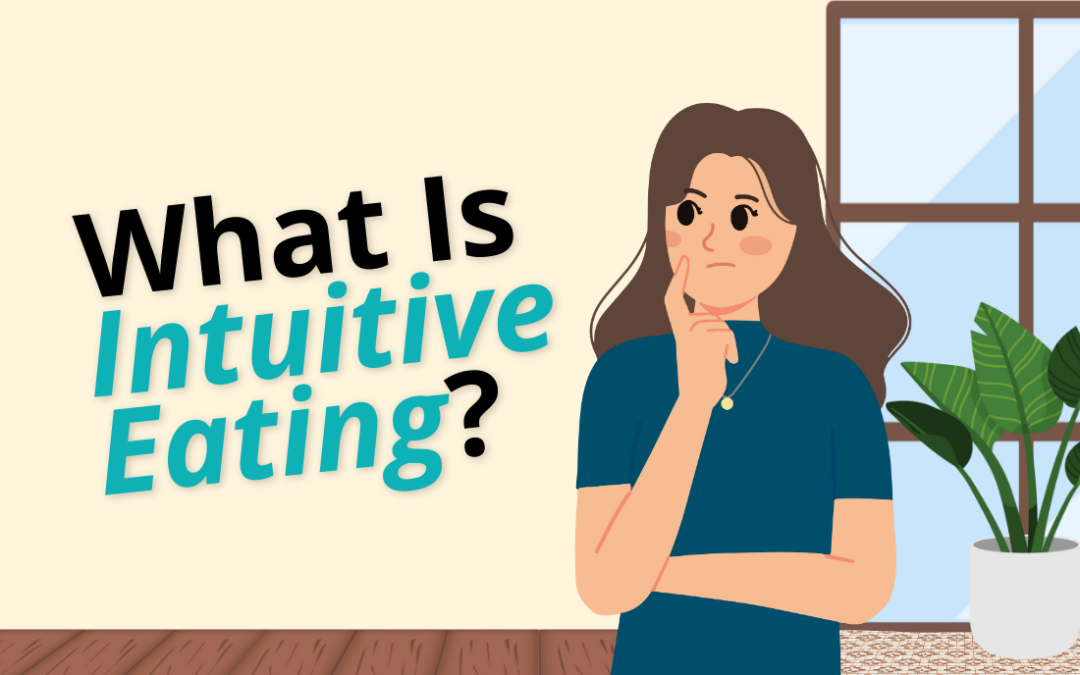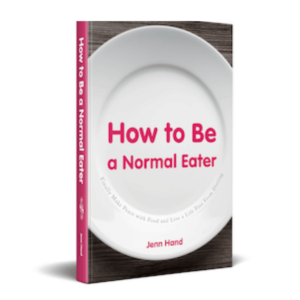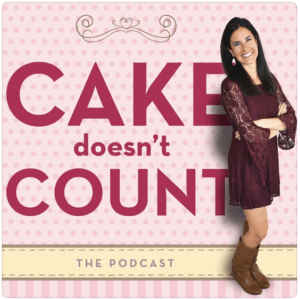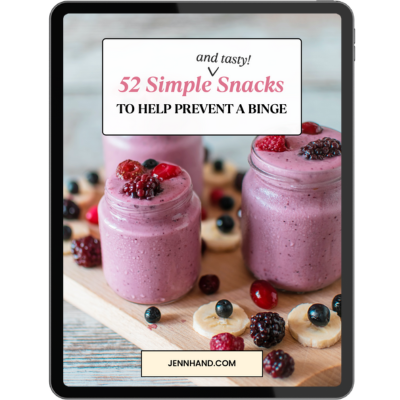Intuitive Eating is a self-care eating approach that encourages listening to your body’s natural hunger and fullness signals. It promotes a healthy relationship with food by prioritizing internal cues over external diet rules, fostering balance, and well-being.
Written by Jenn Hand, Holistic Nutritionist, Board Certified Health Coach, NBC-HWC
Who Coined the Term Intuitive Eating and Is It Legit?
The term “intuitive eating” was first introduced into popular wellness culture by registered dietitian Evelyn Tribole and nutrition therapist Elyse Resch in their 1995 book, titled “Intuitive Eating.” Their work built upon previous research and clinical studies conducted by others.
But is it legit?
Well, according to researchers Julie T Schaefer and Amy B Magnuson, a 2014 review of 24 studies on intuitive eating found that encouraging “individuals to eat intuitively help participants abandon unhealthy weight control behaviors, improve metabolic fitness, increase body satisfaction, and improve psychological distress.”
In my experience as a food coach helping women with binge and emotional eating, I’ve seen these benefits firsthand.
At first clients can often be confused about how to listen to the body, how to honor hunger and fullness, and how to let go of food rules. But over time they feel a sense of freedom and peace with food–no longer feeling trapped by the cycle of dieting and restriction.
They become more attuned to their body’s needs, leading to better overall health and a more positive body image.
There are often surprising benefits that many people don’t expect–being able to feel emotions without eating, better able to handle stress and overwhelm, a more satisfying relationship with their significant other, and rediscovering the joy in food.
This holistic approach not only enhances physical well-being but also fosters a healthier and more compassionate relationship with yourself.
CLICK HERE: To Learn about Intuitive Eating Coaching →
Table of Content
- How Intuitive Eating Works
- How I Combine Intuitive Eating with Structure
- Why Intuitive Eating Isn’t Always the Best Place to Start
- Intuitive Eating vs the Diet Mentality and Diet Culture
- How to Deal with the “Food Police” When Doing Intuitive Eating
- 4 Common Challenges When Starting Intuitive Eating
- What Are the Benefits of Intuitive Eating?
- What Is the Role of a Nutritionist in Guiding Intuitive Eating?
- 10 Main Principles of Intuitive Eating
- Common Questions About Intuitive Eating
How Intuitive Eating Works
Intuitive Eating works by reconnecting you with your body’s innate signals of hunger and fullness.
It encourages you to trust these cues instead of following external diet rules. The approach is rooted in principles that promote listening to your body, making peace with food, and respecting your physical and emotional needs.
By doing so, you cultivate a balanced and healthy relationship with food, free from guilt and restriction.
When I was healing from my own battle with bingeing and restricting, intuitive eating wasn’t as mainstream as it is today. Looking back on my own journey, I did follow the principles of IE but in a very roundabout way.
My very first step was to normalize the rhythm of eating–which is what I teach my clients today.
Eating every 3-4 hours and adding protein to every meal and snack began to bring me out of the diet/binge cycle and into more of a steady even cadence of how I was eating. This enabled me to begin to work on learning to trust and listen to myself around food.
How I Combine Intuitive Eating with Structure
While intuitive eating emphasizes freedom and listening to your body’s cues, some structure can be beneficial, especially in the beginning.
I help clients establish regular meal patterns to fuel their bodies frequently throughout the day.
I teach a way of eating to help build the foundation to begin to hear hunger and fullness. I recommend eating every 3-4 hours, adding protein each time you eat.
This structured approach not only keeps your blood sugar even and steady throughout the day, but it provides a reliable framework to then explore hunger and fullness signals, making the process of intuitive eating more manageable and sustainable.
Most women I work with need some structure in their approach to eating.
To go from a diet and rigid plan to “I’ll just listen to my body” is a massive jump and not one we are prepared for–it’s too far from where we begin to successfully make the leap. By integrating a bit of structure, it allows you to gradually make the transition to eating in a more intuitive way.
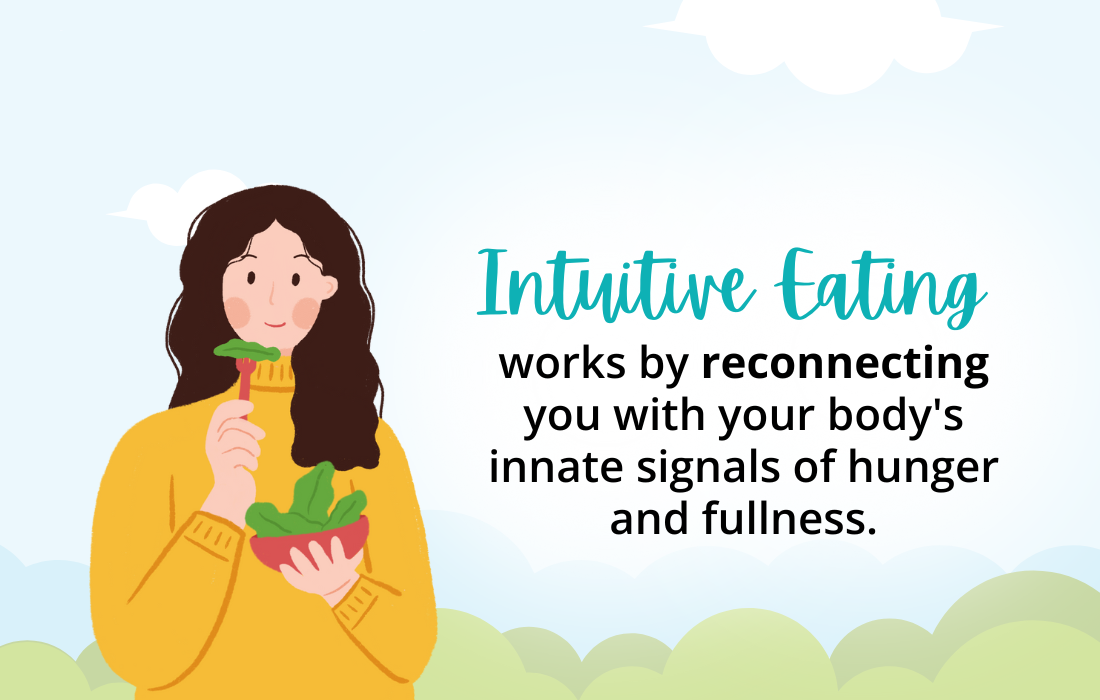
Why Intuitive Eating Isn’t Always the Best Place to Start
If someone has been dieting or binge eating, jumping straight into intuitive eating can be overwhelming without some initial structure.
In theory, intuitive eating is a great way to approach food, but in reality, it can be very challenging. Many of the women I work with become even more confused after reading about intuitive eating.
- Am I supposed to allow all cravings?
- What if I’m not super hungry, do I still eat?
- What if I gain weight?
- How do I know when I’m full?
- What if I still overeat?
- Do I meal plan or just wing it?
These questions can halt progress so it’s worth exploring a more structured approach to food in order to overcome some of the fears. Establishing regular eating patterns by adding protein to your meals and eating every 3-4 hours creates a stable foundation.
From there, you can gradually learn to trust and respond to your body’s cues, making the transition smoother and more effective.
Intuitive Eating vs the Diet Mentality and Diet Culture
Having a diet mentality means adhering to rigid rules about what, when, and how much to eat.
It is often driven by the desire to lose weight or conform to societal standards. Diet culture perpetuates the idea that thinner is better, promoting restriction and deprivation.
Intuitive eating, on the other hand, rejects these external pressures, focusing instead on internal cues and promoting self-compassion and body acceptance. It is about nurturing a healthy relationship with food and your body, free from judgment and restriction.
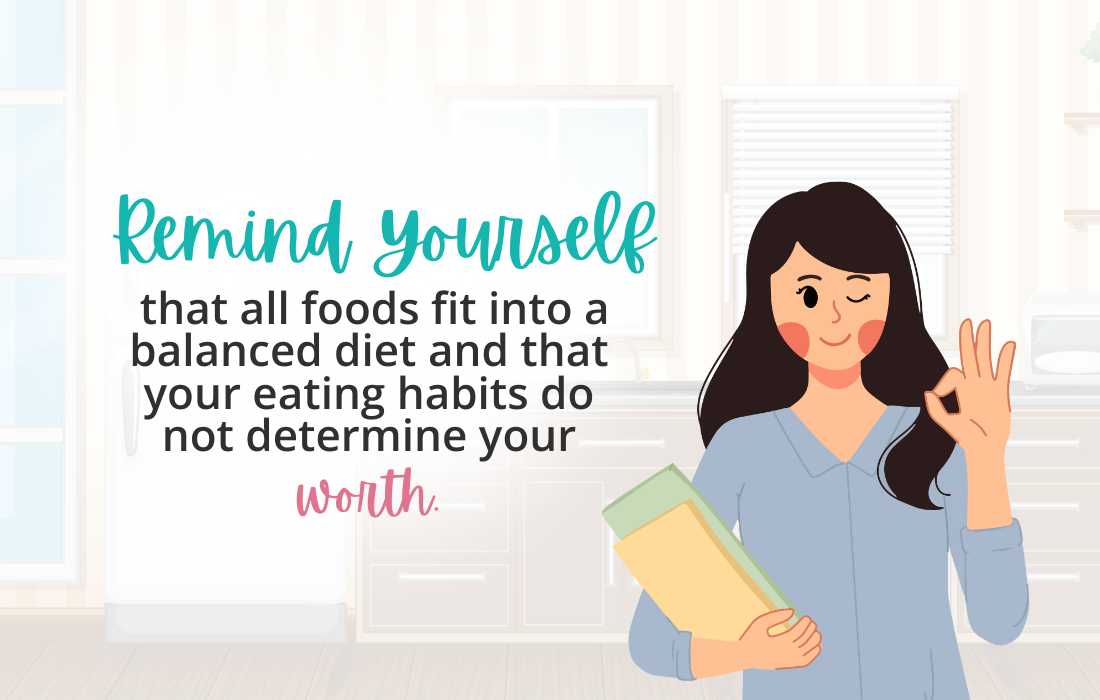
How to Deal with the “Food Police” When Doing Intuitive Eating
The “food police” are the critical voices, both internal and external, that judge your food choices and enforce diet rules.
To deal with them while practicing intuitive eating, it’s essential to challenge these negative thoughts and reframe them. Remind yourself that all foods fit into a balanced diet and that your worth is not determined by your eating habits.
I had a running list of food rules and would tackle them individually.
The “good food/bad food” mentality doesn’t go away overnight–it happens slowly over time, as we gain more experience and trust ourselves to break the rigid rules we learned in the diet world.
4 Common Challenges When Starting Intuitive Eating
1. Letting Go of Diet Rules
We pick up a lot of baggage in the diet world about what’s good and bad, and what we are supposed to eat.
Many people struggle to let go of long-held dieting beliefs, as it can be scary. It takes time to trust that your body knows what it needs.
2. Distinguishing Hunger and Fullness Cues
After years of dieting and following a program, counting macros or points or tracking calories, learning to recognize your natural signals can be challenging.
3. Dealing with Emotional Eating
We’ve learned to use food when dealing with the ups and downs of life.
When we’re working to let go of this pattern, it can be hard to “feel feelings” without eating.
4. Overcoming Fear of Weight Gain
The fear of weight gain is real–it’s often why we try to control our diet in the first place.
It’s terrifying to begin to trust that our bodies know what they need–especially after a lifetime of dieting.
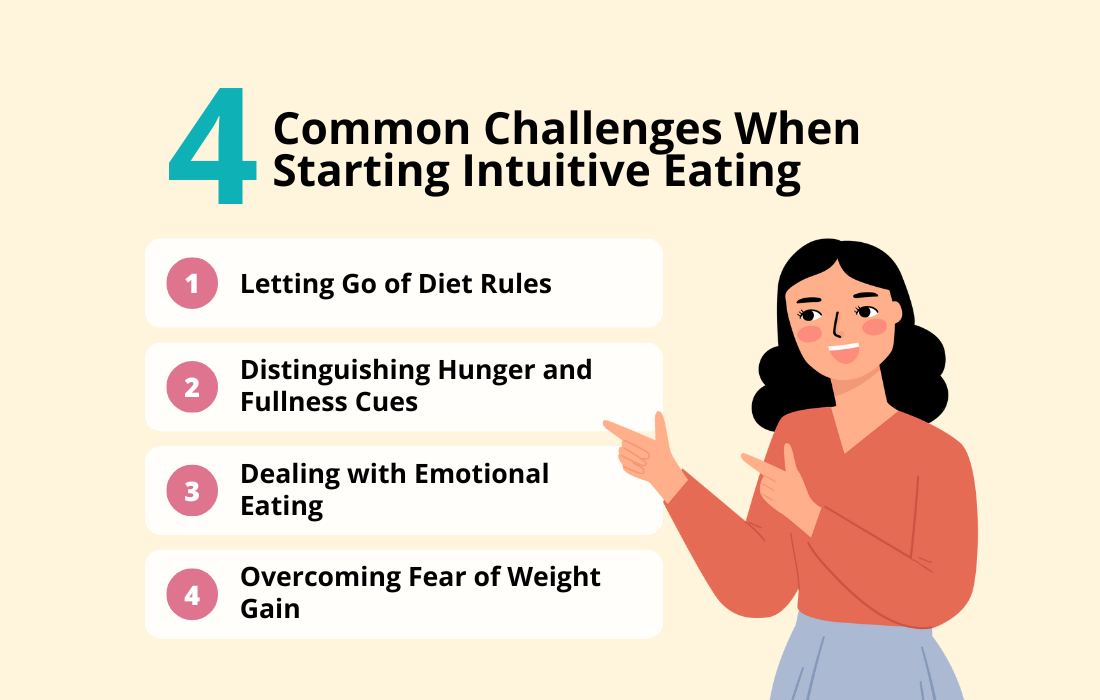
What Are the Benefits of Intuitive Eating?
Intuitive Eating improves physical and mental health by fostering a positive relationship with food.
It reduces stress and anxiety, enhances body satisfaction, and boosts self-esteem. By listening to natural hunger and fullness cues, it promotes better metabolic fitness and overall well-being, supporting sustainable, long-term health. And the best part? Over time, you feel like a sane, normal person around food!
What Is the Role of a Nutritionist in Guiding Intuitive Eating?
A nutritionist provides personalized support and education in Intuitive Eating, helping clients understand and apply its principles.
They assist in overcoming barriers like diet mentality and emotional eating, ensuring balanced eating patterns and nutritional adequacy.
Nutritionists empower individuals to develop a healthier, more intuitive relationship with food. In my practice–my intention is always to guide each person the hearing their own wisdom in themselves so that over time, there is no other book, program or “fix” to buy. They trust themselves around food!
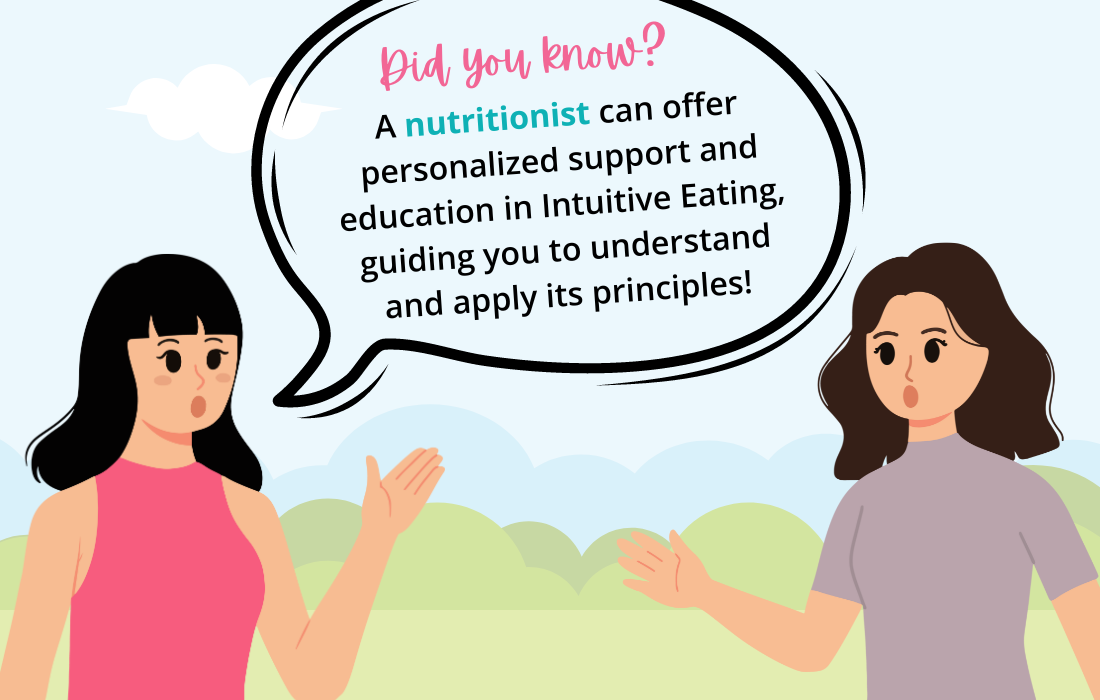
10 Main Principles of Intuitive Eating
Intuitive eating is about reconnecting with your body’s natural cues, rejecting dieting, and giving yourself unconditional permission to eat.
It emphasizes mindful eating, listening to hunger and fullness cues, and cultivating a positive relationship with food and your body. Even though there are 10 principles of intuitive eating–make these your own. Every client I work with is unique and these look different for every person.
Yes, the concepts are the same, but some may resonate more than others or be more suited for where you are in your journey.
I always recommend to start with what resonates and leave the rest! They aren’t all meant to be practiced and explored at once, so find 1-2 that speak to you and start there.
1. Reject Dieting
Rejecting dieting is the foundational principle of intuitive eating. It involves letting go of the diet mentality and embracing a compassionate (and curious!) approach to food and body.
By rejecting restrictive rules and focusing on self-care, individuals can begin to cultivate a healthier relationship with food. Letting go of dieting can be very scary when we’ve spent a lifetime doing it.
I would constantly look at my past dieting history and remind myself that dieting never gave me what I deeply wanted–freedom.
I got caught back up in diets many times on my journey, and each time I learned more deeply that diets don’t work and gave me more confidence that I could find my “normal” if I kept going on this path.
2. Respond to Hunger
Responding to hunger involves tuning into your body’s natural cues and eating when you’re hungry.
It means honoring your hunger without judgment or guilt and trusting that your body knows what it needs. For many people, hearing hunger cues is a re-learning process.
Instead of eating based on rules or shoulds, we get curious about our body’s signals.
- Where do we feel hunger?
- Is it a sensation?
- Are there outward signs?
For me, I feel an energy dip and if I let myself go too long after that, I get hangry.
That’s why the clock is very beneficial at first–eating every 3-4 hours trains your body back into a gentle rhythm of hunger and fueling.
From there you can pay attention to how your body feels and what cues it’s giving you in your energy, mood and physical sensations during the day.
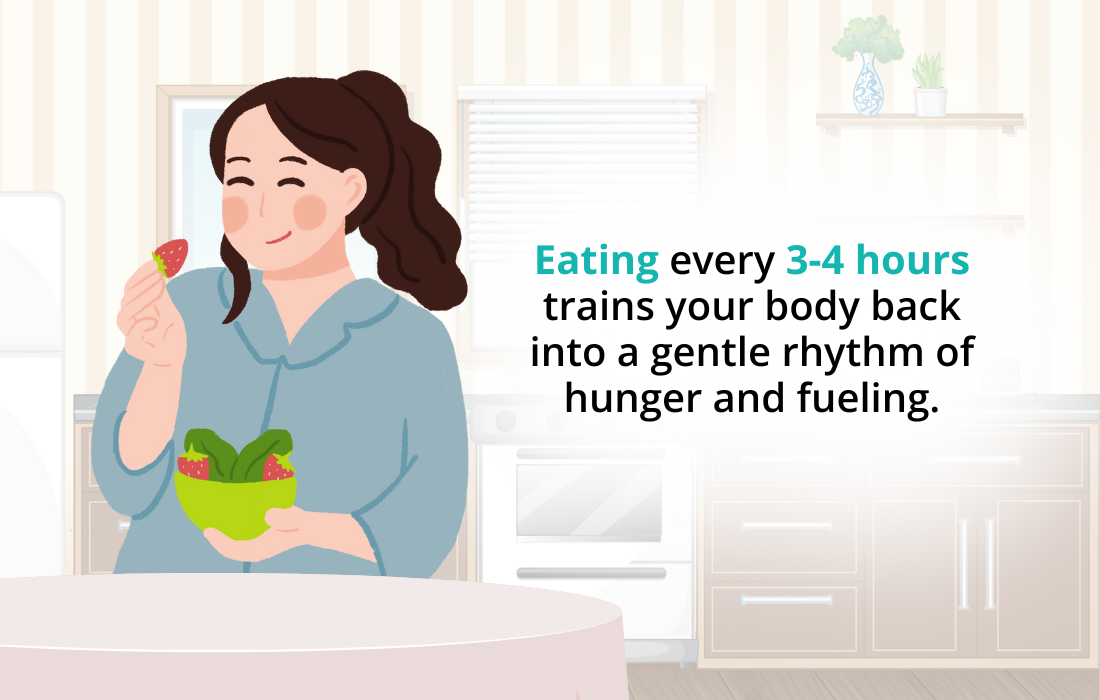
3. Making Peace with Food
Making peace with food entails giving yourself unconditional permission to eat all foods without labeling them as “good” or “bad.”
It involves letting go of food guilt and embracing a balanced approach to eating that includes enjoyment and satisfaction.
This one was a doozy for me and one I think happens over time based on practicing the other principles of intuitive eating. I always guide clients to reframe “good/bad” foods.
Can we look at foods as more or less nourishing or energizing? More or less nutritious or satisfying?
Find words that point you into a different headspace–one not filled with baggage and criticism but exploring how the food feels in your body. By changing the language we use around food, it helps us to choose from a body-based place vs a mind-based place. This naturally helps us feel less guilty about what we are eating!
4. Fighting Food Rules
Fighting food rules means challenging societal norms and diet culture messages that dictate how and what we should eat.
It involves rejecting arbitrary food restrictions and embracing food freedom. This is easy on paper and hard in real life.
For me (and most others), this was done bit by bit and not all at once. I began with “easier” food rules to break. One of my rules was that I couldn’t eat bread or I’d gain weight, so I’d work to have a sandwich 3x a week for lunch.
This was scary but I did it anyway (with a lot of gentle self-talk and permission!) because I wanted to prove to myself that I COULD have bread and still be okay.
Once I got more comfortable with this one, I would challenge another food rule.
Rules like eating after 7pm, not eating dessert during the week, only having “clean” foods during the workweek and about 100 others were all challenged, broken and remade over time. I always recommend starting with one to challenge and break it to prove to yourself you can!
5. Finding Satisfaction
Finding satisfaction in eating is about choosing foods that not only nourish your body but also bring you pleasure and enjoyment.
It involves savoring your meals and paying attention to the sensory experience of eating. In the world of dieting, satisfaction is not even a concept. Eating is only about rules, calories, or nutrients. It’s not about what we find nourishing, satisfying and balancing.
I always approach this topic with clients as an experiment–if rules didn’t matter, what would you eat? If calories didn’t count, what would you pick?
The fear is that we’d eat Oreos and ice cream forever. The reality is that once we take the charge out of some of our forbidden foods, our bodies want nourishing, nutritious food much of the time.
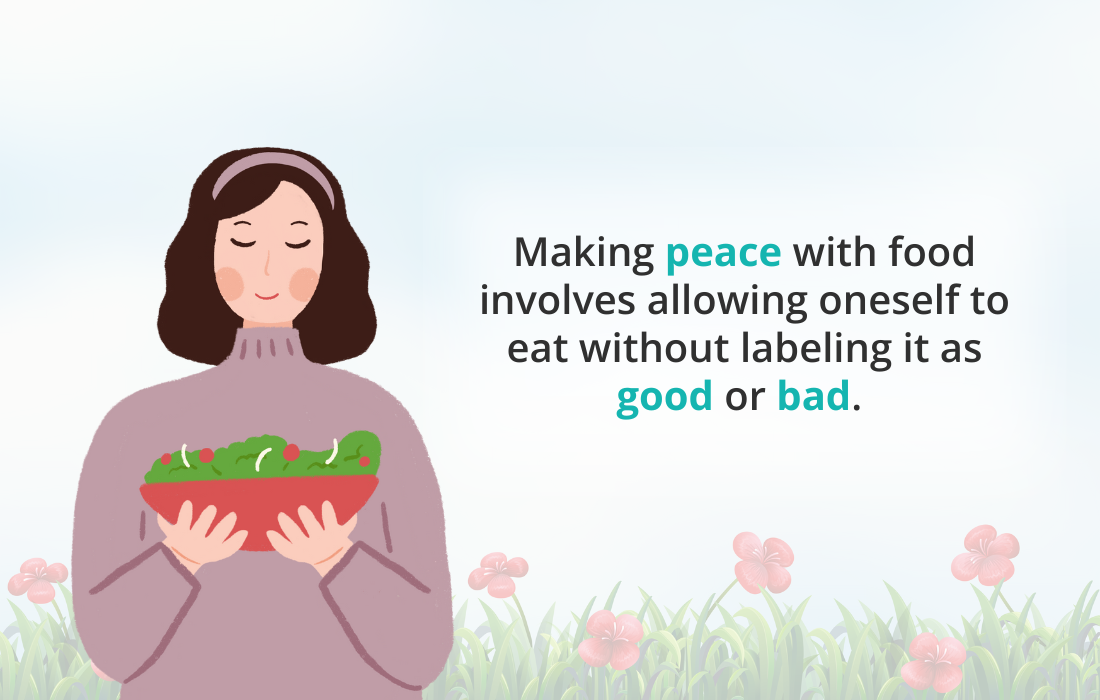
6. Understanding Fullness
Understanding fullness means recognizing when you’ve had enough to eat and stopping when you’re satisfied.
It involves listening to your body’s signals of fullness and respecting its cues. This can be harder to hear than hunger. For many people, hunger gives a clearer signal than fullness. We usually associated fullness with the “binge stuffed” feeling.
But on this path, we need to redefine what fullness is–it’s a gentle, comfortable full.
Often times the process works backward–we guess when we are full and misread the cue and end up overeating. So we learn and try again the next time we eat. It’s a lot of trial and error at first! You take a guess, eat what you chose and then get feedback on whether or not that was “enough.”
Think of fullness as “enough-ness”–was that amount enough to get you through until the next meal? Experiment with eat (and use your journal as a guide if needed!)
7. Managing Emotions
Managing emotions involves acknowledging the role of emotions in eating behavior and finding alternative ways to cope with feelings without turning to food.
It means developing healthy coping mechanisms and self-care practices. For those of us who’ve struggled with food, we grow up using food as a coping mechanism. The good news is that as adults, we can unlearn that pattern. We explore other ways to get our emotional needs met.
- How do we deal with stress and overwhelm?
- What do we do when we are lonely?
- How do we get through a sad time?
Journaling can be a great way to begin attuning yourself to what you need emotionally.
I used my journal for many years as a way to gain clarity, understand what it is I really needed when I binged or wanted to eat, and help me process and move through a challenging feeling. Other great tools for managing emotions are tapping, meditation, breathwork, yoga and any kind of art/writing expression.
8. Body Respect
Body respect involves honoring and accepting your body at any size or shape.
It means treating your body with kindness and compassion and rejecting societal pressures to conform to unrealistic beauty standards. This concept can be challenging in an age of social media and filters. One of the big things that helped me inhabit and appreciate my body was exploring my own spirituality.
I wanted to connect with who I was beyond my body in order to be able to be at peace with myself.
I explored meditation and yoga, which helped me connect to my spirit, soul, inner wisdom (whatever you want to call it). If this doesn’t resonate with you, there are many other approaches like body gratitude, mirror work, EFT, affirmations and journaling to help get in touch with making peace with your size.
To me, this doesn’t mean we can’t want to be at a comfortable weight.
Our bodies desire a natural weight that helps us move with ease. This principle points to the fact that we can’t hate ourselves into change. We have to make peace with where we are body wise in order to open up the space for change.
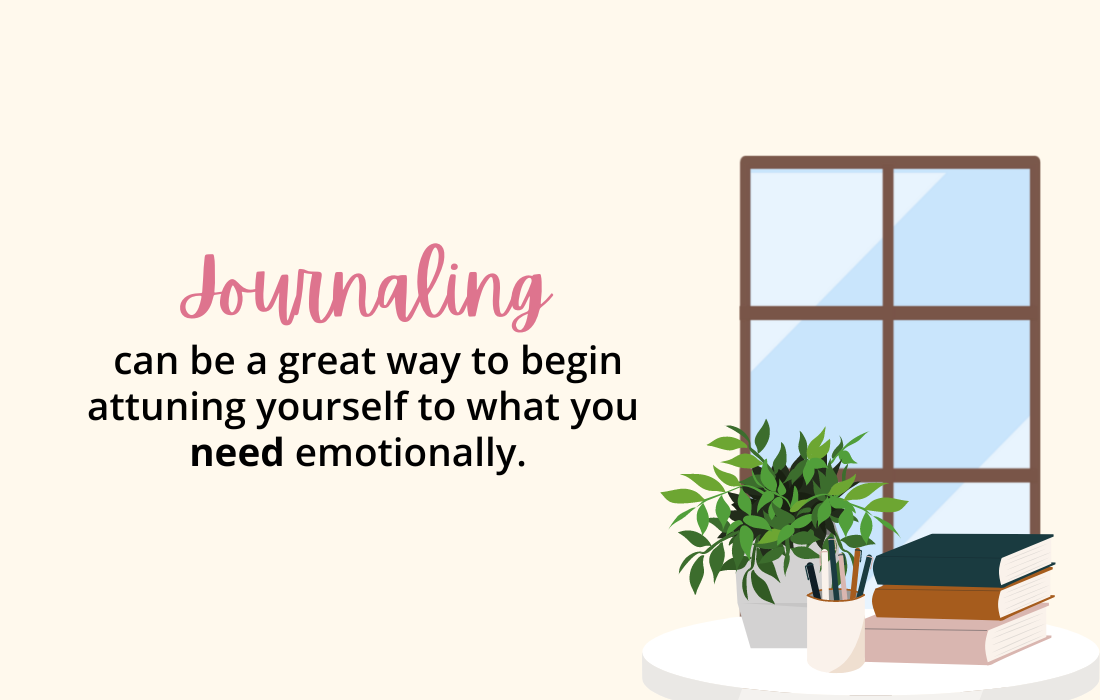
9. Joyful Movement
Joyful movement is about finding physical activities that bring you joy and pleasure rather than exercising as a means of punishment or compensation for eating.
It involves moving your body in ways that feel good and nourishing. In the diet world, “punishment” becomes synonymous with “exercise.” I spent most of my diet and binge eating years using exercise as a form of punishment.
Whenever I binged or overate, I would force myself to go to the gym to slave away on the elliptical.
It took some exploration to explore movement for the sheer joy of moving my body instead of for a “result.” But over time, I found that hiking, yoga, paddle boarding, HIIT workouts, and walking are things I enjoy doing! It’s different for everyone.
Some may love dancing or yoga. Others may find walking their dog something they like. Experiment to see what resonates with your body.
10. Honor Your Health with Gentle Nutrition
Honoring your health means prioritizing your overall well-being and making choices that support your physical, mental, and emotional health.
It involves taking care of your body through balanced nutrition, regular movement, and self-care practices. This usually comes much later in the journey.
At first, there is so much to learn around listening to your body, trusting yourself, how to balance structure and permission, dealing with cravings, hearing hunger and fullness cues, learning what to do when we feel an emotion–that gentle nutrition isn’t something that becomes a focus until later.
Too much information only confuses us more.
When I was getting my master’s in holistic nutrition, I ended up in a period of restriction, as all of the things I learned kept getting into my bed and confusing my body’s signals.
We need to develop a balanced, peaceful relationship with food first before we begin looking at nutrition. I also like to think of nutrition more as “how do I incorporate highly nutritious foods into my meals”–it becomes a way to take care of yourself rather than a rule to follow.
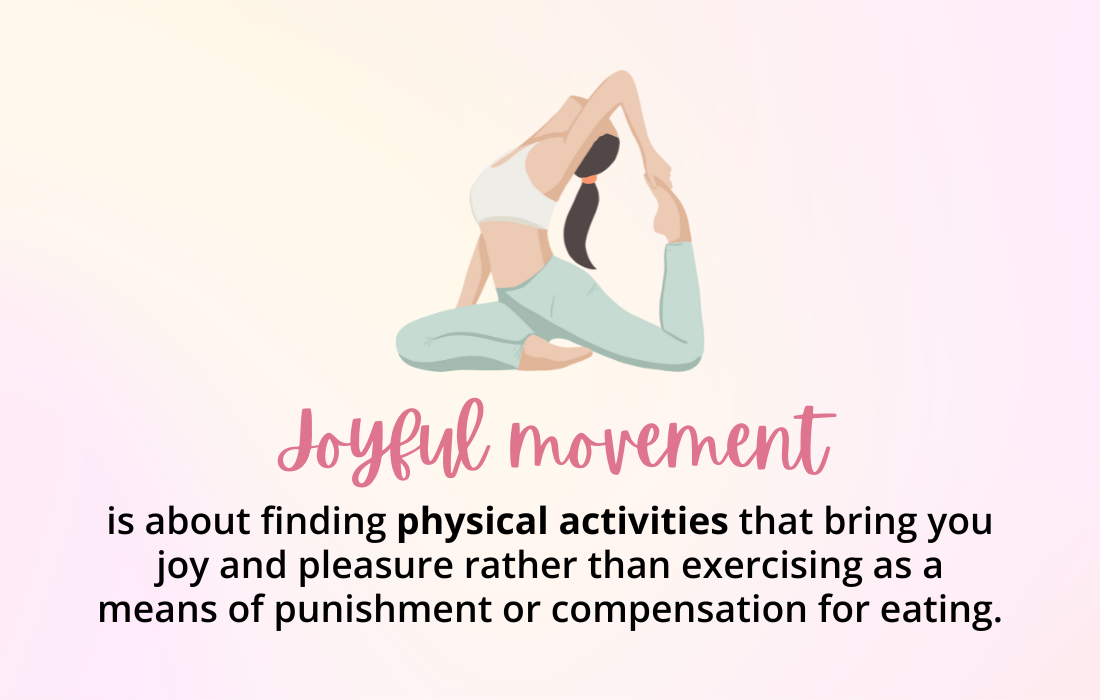
Common Questions About Intuitive Eating
Is intuitive eating healthy?
Yes, intuitive eating is healthy as it promotes a balanced relationship with food and respects the body’s natural signals.
There can be a period where we crave all the foods we had forbidden for so long but over time the body balances itself out as we learn how to honor our rhythms and cues.
Is intuitive eating dangerous?
No, intuitive eating is not dangerous; it encourages mindful and balanced eating habits.
What is the difference between mindful eating and intuitive eating?
Mindful eating focuses on being present during meals, while intuitive eating encompasses listening to hunger and fullness cues along with emotional and physical needs.
Why is it that dieting might not result in weight loss long-term?
Dieting often leads to temporary results and can trigger cycles of restriction and overeating, making long-term weight loss difficult.
We likely also adhere to a very rigid food plan when we are dieting, so if we lose weight in the short term, that way of eating is usually not sustainable in the long run.
Can I lose weight by eating intuitively?
Yes and no. Intuitive eating focuses on health and well-being rather than weight loss; weight outcomes can vary.
For many people, they don’t need to lose weight and the desperation to shed weight is from the body image challenges that many people wrestle with. For others, weight loss is a natural byproduct as you get out of the diet/binge cycle.
What does a day of intuitive eating look like?
For me, I still eat about every 3-4 hours, adding a protein every time I eat.
This is the natural rhythm of my body and when I typically get hungry. I check in with myself to see what foods sound satisfying and choose based on what my body wants vs what a diet rules would say. Intuitive eating can look different for everyone!
What happens to your body when you start intuitive eating?
While your body begins to regulate hunger and fullness more naturally, it can feel very scary to let go of rules.
Typically there are baby steps into intuitive eating–where you don’t just throw out all of your rules and “listen to your body.” You start small, built trust through experience and keep expanding on that progress.
What are the cons of intuitive eating?
Time. In our instant gratificiation society, we want instant results.
Learning to overcome diet mentality, trusting your body’s signals, dealing with emotions, and caring for yourself all take time. (More than worth the journey though!)
Will I gain weight if I start intuitive eating?
Weight changes vary; the focus is on health and well-being rather than weight.
What is gentle nutrition?
Gentle nutrition involves making food choices that honor your health and taste preferences while feeling good.
This usually comes much farther into the journey, as the beginning is focused more on finding balance with yourself and learning how to make peace with food.
Is emotional eating something that I can overcome by doing intuitive eating?
Yes, intuitive eating helps address emotional eating by promoting a healthier relationship with food.
What’s the best way to start my intuitive eating journey?
The very first thing I always recommend is eating every 3-4 hours and adding protein to your meals and snacks.
From there, your body begins to even out and you can work on how to reject the diet mentality and tune into your body’s hunger and fullness cues.
Does intuitive eating help people overcome eating disorders?
Yes, it can support recovery by fostering a healthier, more balanced relationship with food and body image.
This typically requires additional support and its best to seek one on one support while you are recovering.
How can I deal with food cravings when I’m working to eat intuitively?
Your body may be craving specific nutrients that it’s not getting enough of, leading to thoughts about foods rich in those nutrients as your body tries to meet its nutritional requirements.
This is especially true if you lack protein! When dealing with food cravings pay attention to whether it’s a physical, emotional, or mental craving.
Try eating some of the food that you’re craving and see how you feel. Pay attention to how the food tastes and whether you’re truly enjoying the food and feeling nourished. Over time you’ll become attuned to whether it’s a physical, mental or emotional craving.
What is emotional hunger?
Emotional hunger is the desire for food for an emotional reason.
I like to think of emotional hunger as a “red flag” from our body. It’s a sign to go deeper to explore what’s going on underneath the yearning to eat.
Can intuitive eating help people with an eating disorder?
If someone is dealing with a severe eating disorder, then working with a professional is the best bet.
When you’re just getting out of a highly restrictive mentality, diving straight into intuitive eating may be too difficult. Having some structure is often helpful. As you heal, you may decide to move towards intuitive eating with the help of a coach or nutritionist.
What is a “Self Care Eating Framework?”
Intuitive eating is a self care eating framework that can help you get in touch with your true needs and identify what makes you feel nourished.
Related Articles
⚪ Intuitive Eating Coach: How Food Coaching for Normal Eating Works & Is It Right For You?
⚪ Why We Struggle with Intuitive Eating (And Tips To Help!)
⚪ Are You Afraid You’re Doing Intuitive Eating Wrong?
⚪ Intuitive Eating for Weight Loss Tips to Get You Started
Get the Normal Eater’s Newsletter
Join 8000+ women who are overcoming overeating, binge eating, and breaking up with dieting forever. Get Jenn’s inspiring and actionable weekly newsletter with the latest posts, podcasts, and tips on how to love your body, find food freedom, and lose weight holistically.
Get the Normal Eater’s NewsletterWork with an Emotional Eating & Holistic Nutrition Coach
Overcome Bingeing and Emotional Eating, and Break Up with Yo-yo Dieting
Working with an emotional eating coach and holistic nutritionist can help you get free from the frustrating binge and restrict cycle and stop yo-yo dieting.
You don’t have to be obsessed with food or have a million rules around eating to find your natural weight and learn to love your body. Ready to actually see a lasting change and experience true freedom?
Schedule a 20-min CallAbout the Author:

Jenn Hand has been helping women like you become normal eaters since 2015.
She’s worked with thousands of women, helping them to balance their bodies, end bingeing, stop obsessing over food, and start feeling amazing again. As a board-certified health coach and holistic nutritionist, Jenn knows how to support you in making real positive changes that last.
Her articles have been published on Mind Body Green, Tiny Buddha, Thrive Global and other local and global media platforms. She’s the author of How to Be a Normal Eater and the creator of The Normal Eater’s Club program. Listen to Jenn’s advice and tips on the Cake Doesn’t Count Podcast, or read more of her articles for free on the Food Freedom Blog.
Learn About Coaching!
